February 11, 2016 at 3:32 pm
[caption id="attachment_1276" align="alignright" width="598"]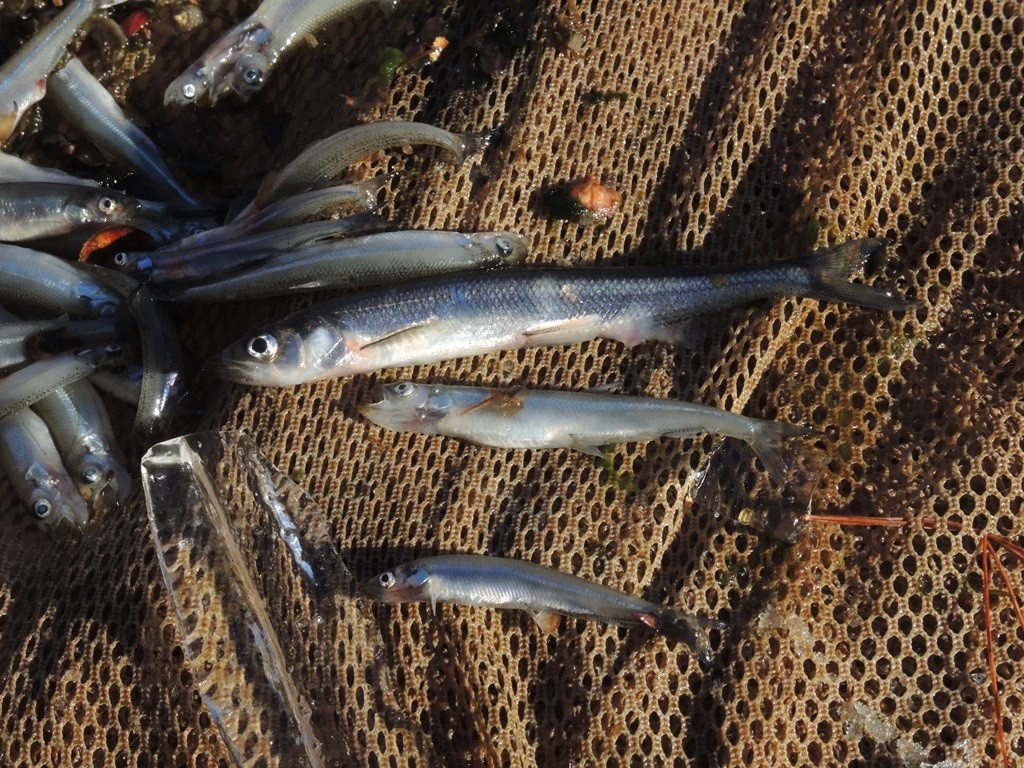 These three different-sized smelt represent three different age classes.[/caption]
How can one tiny fish be the key to so many larger fish? The rainbow smelt may be diminutive in size but its impact is huge. That’s why IFW fisheries biologists like Tim Obrey keep an eye on smelt populations on Maine’s landlocked salmon waters.
You see, smelt are the primary forage for salmon. While other fish such as brook trout and togue can adjust their diet to other food sources, salmon aren’t as adaptable. When smelt aren’t available, it impacts the salmon population.
In some ways, you can monitor how well the smelt population is doing simply by the health of the salmon population. When smelt are numerous, salmon are fat and happy. When smelt populations decline, you can see the difference in the weights of salmon. Salmon become sleeker and more slender.
[caption id="attachment_1275" align="alignleft" width="405"]
These three different-sized smelt represent three different age classes.[/caption]
How can one tiny fish be the key to so many larger fish? The rainbow smelt may be diminutive in size but its impact is huge. That’s why IFW fisheries biologists like Tim Obrey keep an eye on smelt populations on Maine’s landlocked salmon waters.
You see, smelt are the primary forage for salmon. While other fish such as brook trout and togue can adjust their diet to other food sources, salmon aren’t as adaptable. When smelt aren’t available, it impacts the salmon population.
In some ways, you can monitor how well the smelt population is doing simply by the health of the salmon population. When smelt are numerous, salmon are fat and happy. When smelt populations decline, you can see the difference in the weights of salmon. Salmon become sleeker and more slender.
[caption id="attachment_1275" align="alignleft" width="405"]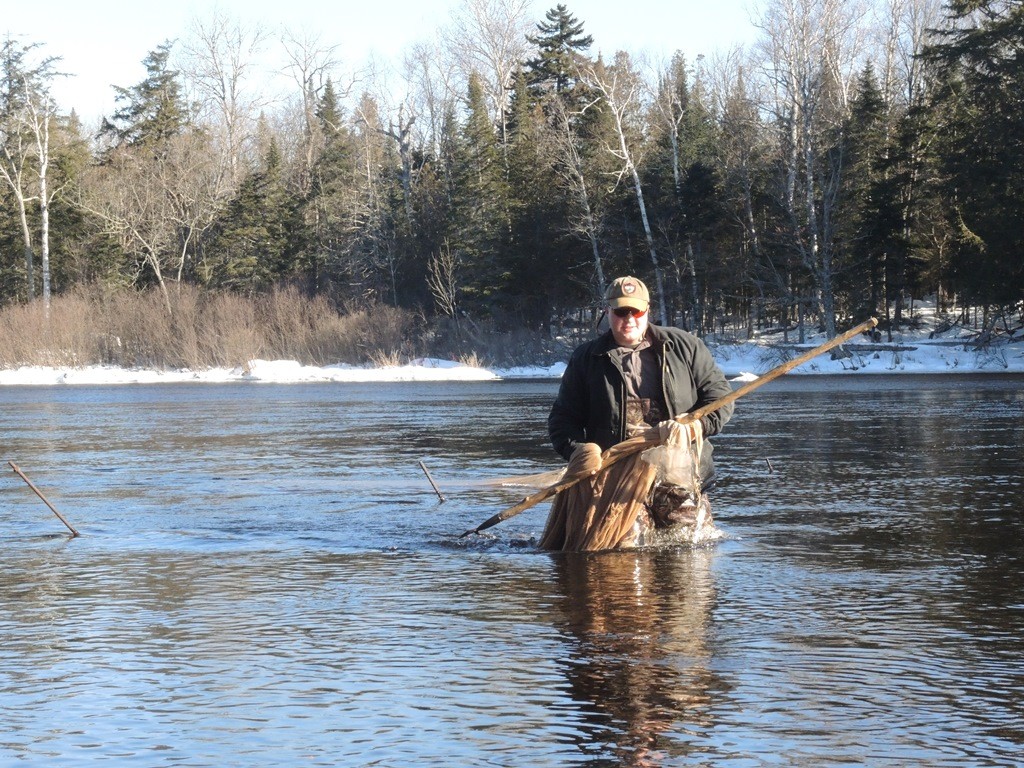 Fisheries assistant Kody Favreau retrieves one of the nets and wades to shore.[/caption]
So in order to keep salmon populations strong and robust, IFW fisheries biologists monitor smelt populations in a number of waterways.
Moosehead Lake possesses a very popular salmon fishery, and the Moose River and Brassua Lake are a smelt nursery for Moosehead Lake, providing essential forage for Moosehead’s salmon.
On the Moose River, IFW biologists and fisheries assistant Kody Favreau are monitoring the smelt population through netting. Favreau places funnel nets on two different sections of the river for a 24 hour set once a week. The nets, which have an opening about 4 feet in a diameter, collect smelt as they drift downstream.
The nets may only cover a small portion of the river, but by monitoring what they catch and multiplying it by a factor to cover the width of the river, biologists can get a better idea of how many smelt are passing through the Brassua Lake Dam, and dropping down into Moosehead Lake.
[caption id="attachment_1278" align="alignright" width="320"]
Fisheries assistant Kody Favreau retrieves one of the nets and wades to shore.[/caption]
So in order to keep salmon populations strong and robust, IFW fisheries biologists monitor smelt populations in a number of waterways.
Moosehead Lake possesses a very popular salmon fishery, and the Moose River and Brassua Lake are a smelt nursery for Moosehead Lake, providing essential forage for Moosehead’s salmon.
On the Moose River, IFW biologists and fisheries assistant Kody Favreau are monitoring the smelt population through netting. Favreau places funnel nets on two different sections of the river for a 24 hour set once a week. The nets, which have an opening about 4 feet in a diameter, collect smelt as they drift downstream.
The nets may only cover a small portion of the river, but by monitoring what they catch and multiplying it by a factor to cover the width of the river, biologists can get a better idea of how many smelt are passing through the Brassua Lake Dam, and dropping down into Moosehead Lake.
[caption id="attachment_1278" align="alignright" width="320"]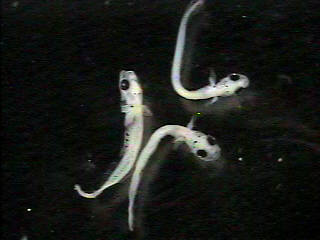 These smelt fry, which were caught this summer, are about a month old and are not as temperature-sensitive as adult smelt.[/caption]
By monitoring the number of smelts in the Moose River, biologists can make sure that the salmon population stays strong and healthy. If the smelt population rises, biologists can adjust the number of salmon stocked in the lake or adjust regulations. If the number of smelt decreases rapidly, biologists can reduce the number of salmon stocked or adjust the fishing regulations to accommodate that.
By monitoring the river throughout the year, biologists also learn more about smelt behavior, as there is quite a variation in the number and age of smelts dropping down depending on the time of year.
For instance, biologists captured 187 smelts in April, 246 in May, but that dropped to a single smelt in June. In July, the numbers jumped up to 103, but these were smaller smelt fry, not adults. Smelt fry are not as temperature sensitive as adults, and can tolerate warmer water, so they are near the surface.
[caption id="attachment_1277" align="alignright" width="464"]
These smelt fry, which were caught this summer, are about a month old and are not as temperature-sensitive as adult smelt.[/caption]
By monitoring the number of smelts in the Moose River, biologists can make sure that the salmon population stays strong and healthy. If the smelt population rises, biologists can adjust the number of salmon stocked in the lake or adjust regulations. If the number of smelt decreases rapidly, biologists can reduce the number of salmon stocked or adjust the fishing regulations to accommodate that.
By monitoring the river throughout the year, biologists also learn more about smelt behavior, as there is quite a variation in the number and age of smelts dropping down depending on the time of year.
For instance, biologists captured 187 smelts in April, 246 in May, but that dropped to a single smelt in June. In July, the numbers jumped up to 103, but these were smaller smelt fry, not adults. Smelt fry are not as temperature sensitive as adults, and can tolerate warmer water, so they are near the surface.
[caption id="attachment_1277" align="alignright" width="464"]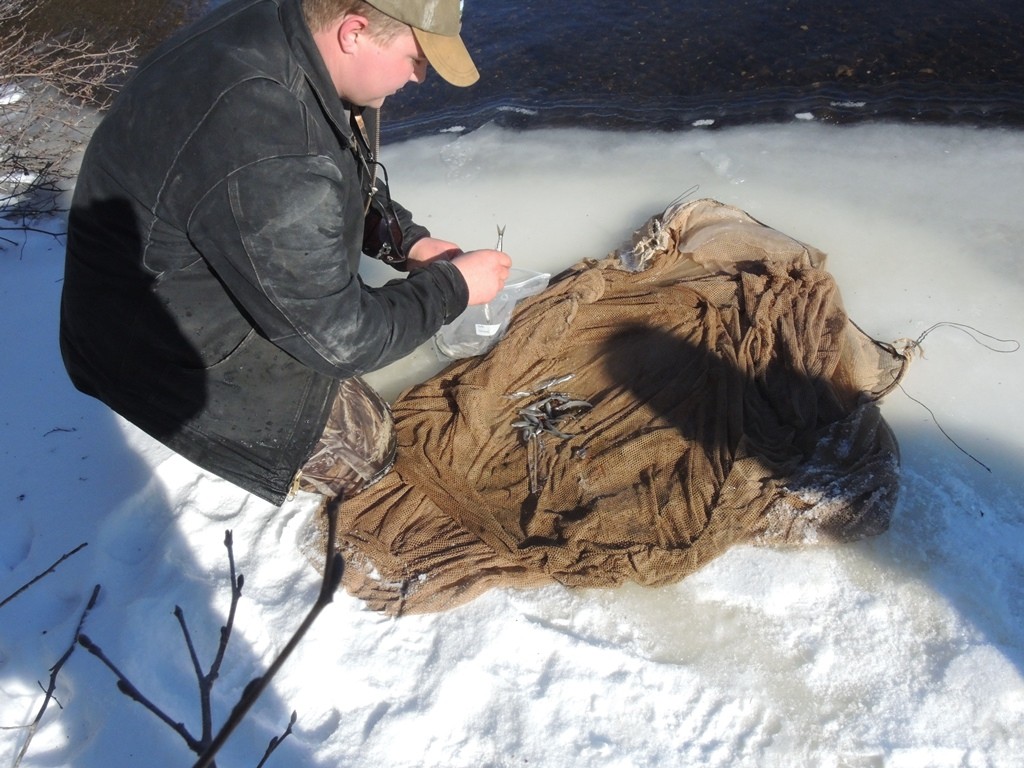 Fisheries assistant Kody Favreau bags the day's catch of smelts. These smelts are taken to the lab to be analyzed later.[/caption]
The salmon population is under a close eye on Moosehead. Obrey and others have liberalized regulations on lake trout in order to decrease and change the composition of the togue population in Moosehead Lake. There are now fewer, but larger, togue in Moosehead, which helps the smelt population.
Salmon growth has rebounded. Since 2008, when the new regulations placed no size or bag limit on togue, salmon weights increased for five straight years. However, in 2013, the salmon size quality took a step backwards due to what was believed to be a swing in the smelt population.
Looking back, Obrey felt that the early ice out and warm temperatures, which was followed by an intense cold snap, caused some high mortality with the smelt population, decreasing the amount of food available for salmon. Since that time, the smelt population has been climbing and salmon weights with them.
The netting gives biologists insight into smelt abundance, and it’s one more piece of the puzzle that gives biologists more information on how to better manage the salmon population.
[caption id="attachment_1273" align="aligncenter" width="1024"]
Fisheries assistant Kody Favreau bags the day's catch of smelts. These smelts are taken to the lab to be analyzed later.[/caption]
The salmon population is under a close eye on Moosehead. Obrey and others have liberalized regulations on lake trout in order to decrease and change the composition of the togue population in Moosehead Lake. There are now fewer, but larger, togue in Moosehead, which helps the smelt population.
Salmon growth has rebounded. Since 2008, when the new regulations placed no size or bag limit on togue, salmon weights increased for five straight years. However, in 2013, the salmon size quality took a step backwards due to what was believed to be a swing in the smelt population.
Looking back, Obrey felt that the early ice out and warm temperatures, which was followed by an intense cold snap, caused some high mortality with the smelt population, decreasing the amount of food available for salmon. Since that time, the smelt population has been climbing and salmon weights with them.
The netting gives biologists insight into smelt abundance, and it’s one more piece of the puzzle that gives biologists more information on how to better manage the salmon population.
[caption id="attachment_1273" align="aligncenter" width="1024"]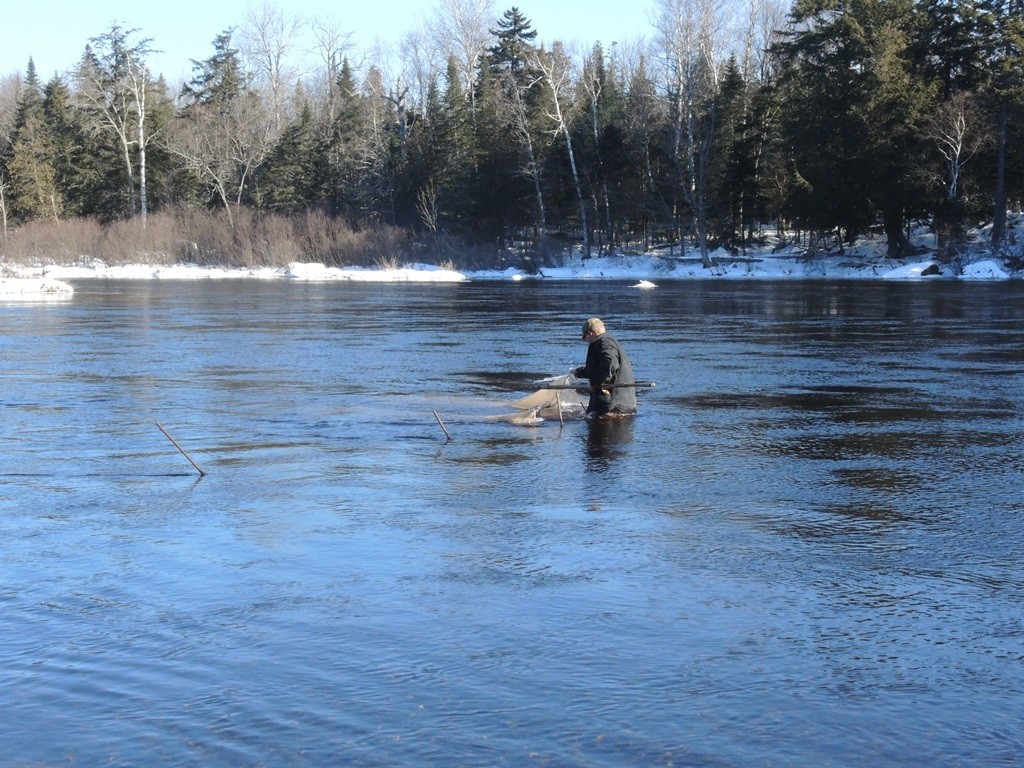 Waist deep in the Moose River, fisheries assistant Kody Favreau sets the nets to trap smelts. The nets are set for 24 hours once every week in order to monitor how many smelt are passing from Brassua Lake into Moosehead Lake.[/caption]
Waist deep in the Moose River, fisheries assistant Kody Favreau sets the nets to trap smelts. The nets are set for 24 hours once every week in order to monitor how many smelt are passing from Brassua Lake into Moosehead Lake.[/caption]
 These three different-sized smelt represent three different age classes.[/caption]
How can one tiny fish be the key to so many larger fish? The rainbow smelt may be diminutive in size but its impact is huge. That’s why IFW fisheries biologists like Tim Obrey keep an eye on smelt populations on Maine’s landlocked salmon waters.
You see, smelt are the primary forage for salmon. While other fish such as brook trout and togue can adjust their diet to other food sources, salmon aren’t as adaptable. When smelt aren’t available, it impacts the salmon population.
In some ways, you can monitor how well the smelt population is doing simply by the health of the salmon population. When smelt are numerous, salmon are fat and happy. When smelt populations decline, you can see the difference in the weights of salmon. Salmon become sleeker and more slender.
[caption id="attachment_1275" align="alignleft" width="405"]
These three different-sized smelt represent three different age classes.[/caption]
How can one tiny fish be the key to so many larger fish? The rainbow smelt may be diminutive in size but its impact is huge. That’s why IFW fisheries biologists like Tim Obrey keep an eye on smelt populations on Maine’s landlocked salmon waters.
You see, smelt are the primary forage for salmon. While other fish such as brook trout and togue can adjust their diet to other food sources, salmon aren’t as adaptable. When smelt aren’t available, it impacts the salmon population.
In some ways, you can monitor how well the smelt population is doing simply by the health of the salmon population. When smelt are numerous, salmon are fat and happy. When smelt populations decline, you can see the difference in the weights of salmon. Salmon become sleeker and more slender.
[caption id="attachment_1275" align="alignleft" width="405"] Fisheries assistant Kody Favreau retrieves one of the nets and wades to shore.[/caption]
So in order to keep salmon populations strong and robust, IFW fisheries biologists monitor smelt populations in a number of waterways.
Moosehead Lake possesses a very popular salmon fishery, and the Moose River and Brassua Lake are a smelt nursery for Moosehead Lake, providing essential forage for Moosehead’s salmon.
On the Moose River, IFW biologists and fisheries assistant Kody Favreau are monitoring the smelt population through netting. Favreau places funnel nets on two different sections of the river for a 24 hour set once a week. The nets, which have an opening about 4 feet in a diameter, collect smelt as they drift downstream.
The nets may only cover a small portion of the river, but by monitoring what they catch and multiplying it by a factor to cover the width of the river, biologists can get a better idea of how many smelt are passing through the Brassua Lake Dam, and dropping down into Moosehead Lake.
[caption id="attachment_1278" align="alignright" width="320"]
Fisheries assistant Kody Favreau retrieves one of the nets and wades to shore.[/caption]
So in order to keep salmon populations strong and robust, IFW fisheries biologists monitor smelt populations in a number of waterways.
Moosehead Lake possesses a very popular salmon fishery, and the Moose River and Brassua Lake are a smelt nursery for Moosehead Lake, providing essential forage for Moosehead’s salmon.
On the Moose River, IFW biologists and fisheries assistant Kody Favreau are monitoring the smelt population through netting. Favreau places funnel nets on two different sections of the river for a 24 hour set once a week. The nets, which have an opening about 4 feet in a diameter, collect smelt as they drift downstream.
The nets may only cover a small portion of the river, but by monitoring what they catch and multiplying it by a factor to cover the width of the river, biologists can get a better idea of how many smelt are passing through the Brassua Lake Dam, and dropping down into Moosehead Lake.
[caption id="attachment_1278" align="alignright" width="320"] These smelt fry, which were caught this summer, are about a month old and are not as temperature-sensitive as adult smelt.[/caption]
By monitoring the number of smelts in the Moose River, biologists can make sure that the salmon population stays strong and healthy. If the smelt population rises, biologists can adjust the number of salmon stocked in the lake or adjust regulations. If the number of smelt decreases rapidly, biologists can reduce the number of salmon stocked or adjust the fishing regulations to accommodate that.
By monitoring the river throughout the year, biologists also learn more about smelt behavior, as there is quite a variation in the number and age of smelts dropping down depending on the time of year.
For instance, biologists captured 187 smelts in April, 246 in May, but that dropped to a single smelt in June. In July, the numbers jumped up to 103, but these were smaller smelt fry, not adults. Smelt fry are not as temperature sensitive as adults, and can tolerate warmer water, so they are near the surface.
[caption id="attachment_1277" align="alignright" width="464"]
These smelt fry, which were caught this summer, are about a month old and are not as temperature-sensitive as adult smelt.[/caption]
By monitoring the number of smelts in the Moose River, biologists can make sure that the salmon population stays strong and healthy. If the smelt population rises, biologists can adjust the number of salmon stocked in the lake or adjust regulations. If the number of smelt decreases rapidly, biologists can reduce the number of salmon stocked or adjust the fishing regulations to accommodate that.
By monitoring the river throughout the year, biologists also learn more about smelt behavior, as there is quite a variation in the number and age of smelts dropping down depending on the time of year.
For instance, biologists captured 187 smelts in April, 246 in May, but that dropped to a single smelt in June. In July, the numbers jumped up to 103, but these were smaller smelt fry, not adults. Smelt fry are not as temperature sensitive as adults, and can tolerate warmer water, so they are near the surface.
[caption id="attachment_1277" align="alignright" width="464"] Fisheries assistant Kody Favreau bags the day's catch of smelts. These smelts are taken to the lab to be analyzed later.[/caption]
The salmon population is under a close eye on Moosehead. Obrey and others have liberalized regulations on lake trout in order to decrease and change the composition of the togue population in Moosehead Lake. There are now fewer, but larger, togue in Moosehead, which helps the smelt population.
Salmon growth has rebounded. Since 2008, when the new regulations placed no size or bag limit on togue, salmon weights increased for five straight years. However, in 2013, the salmon size quality took a step backwards due to what was believed to be a swing in the smelt population.
Looking back, Obrey felt that the early ice out and warm temperatures, which was followed by an intense cold snap, caused some high mortality with the smelt population, decreasing the amount of food available for salmon. Since that time, the smelt population has been climbing and salmon weights with them.
The netting gives biologists insight into smelt abundance, and it’s one more piece of the puzzle that gives biologists more information on how to better manage the salmon population.
[caption id="attachment_1273" align="aligncenter" width="1024"]
Fisheries assistant Kody Favreau bags the day's catch of smelts. These smelts are taken to the lab to be analyzed later.[/caption]
The salmon population is under a close eye on Moosehead. Obrey and others have liberalized regulations on lake trout in order to decrease and change the composition of the togue population in Moosehead Lake. There are now fewer, but larger, togue in Moosehead, which helps the smelt population.
Salmon growth has rebounded. Since 2008, when the new regulations placed no size or bag limit on togue, salmon weights increased for five straight years. However, in 2013, the salmon size quality took a step backwards due to what was believed to be a swing in the smelt population.
Looking back, Obrey felt that the early ice out and warm temperatures, which was followed by an intense cold snap, caused some high mortality with the smelt population, decreasing the amount of food available for salmon. Since that time, the smelt population has been climbing and salmon weights with them.
The netting gives biologists insight into smelt abundance, and it’s one more piece of the puzzle that gives biologists more information on how to better manage the salmon population.
[caption id="attachment_1273" align="aligncenter" width="1024"] Waist deep in the Moose River, fisheries assistant Kody Favreau sets the nets to trap smelts. The nets are set for 24 hours once every week in order to monitor how many smelt are passing from Brassua Lake into Moosehead Lake.[/caption]
Waist deep in the Moose River, fisheries assistant Kody Favreau sets the nets to trap smelts. The nets are set for 24 hours once every week in order to monitor how many smelt are passing from Brassua Lake into Moosehead Lake.[/caption]Categories